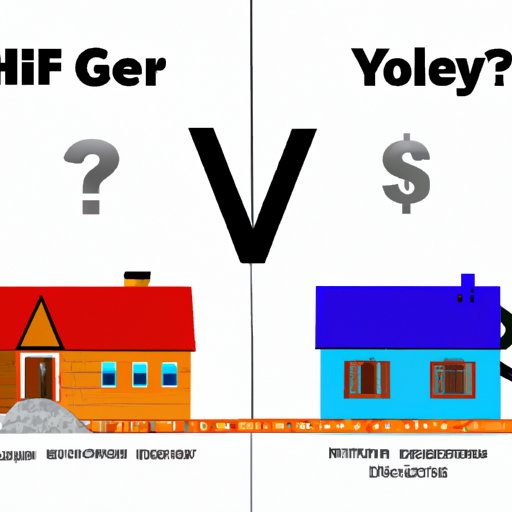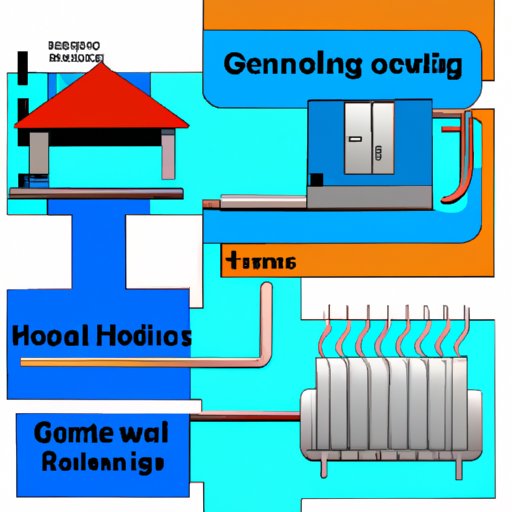Introduction
Geothermal heating and cooling is an energy-efficient way to heat and cool your home or business. It utilizes the earth’s natural temperature to transfer heat or cold air into or out of your building. But how does geothermal heating and cooling work? In this article, we’ll explore the technology behind it, the benefits of investing in a geothermal system, and the costs associated with it.

Overview of Geothermal Heating and Cooling: Explaining the Basics
To understand how geothermal heating and cooling works, it’s important to first understand what geothermal energy is. Geothermal energy is the energy stored in the form of heat beneath the Earth’s surface. This energy can be harnessed to provide heating and cooling for buildings, as well as hot water. Geothermal systems use the constant temperature of the earth to provide heating and cooling for buildings.
Geothermal systems are made up of two main components: a heat pump, which transfers heat from one place to another, and a loop system, which runs beneath the ground and circulates fluid to draw heat from the earth. The heat pump takes the heat from the earth and transfers it into the building, while the loop system draws heat from the building and deposits it back into the earth. The loop system can be either open or closed, depending on the type of system you have.
There are three main types of geothermal heating and cooling systems: direct exchange (DX) systems, vertical loop systems, and horizontal loop systems. DX systems use pipes that run directly below the earth’s surface to transfer heat. Vertical loop systems use boreholes drilled deep into the earth to circulate the fluid, while horizontal loop systems use trenches that are dug horizontally across the property.
How Does Geothermal Energy Work? Examining the Technology Behind It
The technology behind geothermal heating and cooling is fairly simple. Heat pumps are used to transfer heat from one place to another. In a geothermal system, the heat pump takes heat from the earth and transfers it into the building. The pump then circulates the heated air throughout the building, providing a comfortable indoor environment.
The components of a geothermal system include a compressor, an evaporator coil, a condenser coil, and a refrigerant line. The compressor compresses the refrigerant to increase its pressure, allowing it to absorb more heat. The evaporator coil absorbs the heat from the earth and transfers it to the refrigerant. The condenser coil then releases the heat into the building. Finally, the refrigerant line carries the refrigerant back to the compressor to start the cycle again.
Geothermal systems offer several key benefits. First, they are highly efficient, using up to 70% less energy than traditional HVAC systems. They also require minimal maintenance and are extremely quiet. Finally, geothermal systems are environmentally friendly, helping to reduce carbon emissions.
Exploring the Benefits of Geothermal Heating and Cooling Systems
Geothermal systems offer several key benefits. The most obvious benefit is cost savings. Geothermal systems are much more energy efficient than traditional HVAC systems, so they require less energy to operate and are cheaper to maintain. Geothermal systems also help to reduce your environmental impact. By using the earth’s natural heat, they reduce the need for burning fossil fuels to generate electricity.
In addition to cost savings and environmental benefits, geothermal systems also provide increased comfort. Since the temperature of the earth stays relatively consistent throughout the year, geothermal systems can provide a more consistent temperature in your home or office. Additionally, since the system uses the earth’s natural temperature, it won’t be affected by extreme weather conditions.

Comparing Costs of Geothermal vs Traditional HVAC Systems
When deciding whether to invest in a geothermal system, it’s important to consider both the initial investment and the long-term operating costs. The initial cost of a geothermal system is typically higher than a traditional HVAC system, but the long-term savings can be substantial. Because geothermal systems are more efficient, they require less energy to operate and are cheaper to maintain.
Additionally, geothermal systems may qualify for government incentives or tax credits, making them even more affordable. Some utility companies also offer rebates or other incentives for installing a geothermal system. These incentives can help offset the initial cost and make geothermal systems even more appealing.

A Look at the Latest Advances in Geothermal Technology
As geothermal technology continues to advance, new features are becoming available that make geothermal systems even more efficient and cost-effective. Automation is one of the latest advances in geothermal technology. Automated systems allow you to control the temperature of your home remotely, giving you added convenience and energy savings.
Smart thermostats are also becoming increasingly popular. Smart thermostats allow you to program your geothermal system to adjust the temperature based on your preferences and usage patterns. This helps to optimize energy efficiency and cost savings.
Finally, solar-assisted heat pumps are emerging as a viable option for homeowners who want to take advantage of both geothermal and solar energy. Solar-assisted heat pumps use solar panels to collect energy from the sun, which is then used to supplement the geothermal system.
Conclusion
Geothermal heating and cooling is an efficient and cost-effective way to heat and cool your home or business. It utilizes the earth’s natural temperature to transfer heat or cold air into or out of your building. By understanding the basics of how geothermal energy works and exploring the benefits and technology behind it, you can make an informed decision about whether investing in a geothermal system is right for you.
(Note: Is this article not meeting your expectations? Do you have knowledge or insights to share? Unlock new opportunities and expand your reach by joining our authors team. Click Registration to join us and share your expertise with our readers.)
